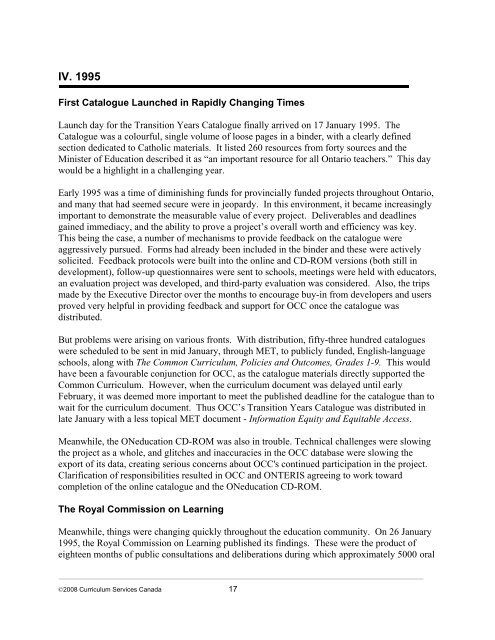a history of curriculum services canada
a history of curriculum services canada
a history of curriculum services canada
Create successful ePaper yourself
Turn your PDF publications into a flip-book with our unique Google optimized e-Paper software.
IV. 1995<br />
First Catalogue Launched in Rapidly Changing Times<br />
Launch day for the Transition Years Catalogue finally arrived on 17 January 1995. The<br />
Catalogue was a colourful, single volume <strong>of</strong> loose pages in a binder, with a clearly defined<br />
section dedicated to Catholic materials. It listed 260 resources from forty sources and the<br />
Minister <strong>of</strong> Education described it as “an important resource for all Ontario teachers.” This day<br />
would be a highlight in a challenging year.<br />
Early 1995 was a time <strong>of</strong> diminishing funds for provincially funded projects throughout Ontario,<br />
and many that had seemed secure were in jeopardy. In this environment, it became increasingly<br />
important to demonstrate the measurable value <strong>of</strong> every project. Deliverables and deadlines<br />
gained immediacy, and the ability to prove a project’s overall worth and efficiency was key.<br />
This being the case, a number <strong>of</strong> mechanisms to provide feedback on the catalogue were<br />
aggressively pursued. Forms had already been included in the binder and these were actively<br />
solicited. Feedback protocols were built into the online and CD-ROM versions (both still in<br />
development), follow-up questionnaires were sent to schools, meetings were held with educators,<br />
an evaluation project was developed, and third-party evaluation was considered. Also, the trips<br />
made by the Executive Director over the months to encourage buy-in from developers and users<br />
proved very helpful in providing feedback and support for OCC once the catalogue was<br />
distributed.<br />
But problems were arising on various fronts. With distribution, fifty-three hundred catalogues<br />
were scheduled to be sent in mid January, through MET, to publicly funded, English-language<br />
schools, along with The Common Curriculum, Policies and Outcomes, Grades 1-9. This would<br />
have been a favourable conjunction for OCC, as the catalogue materials directly supported the<br />
Common Curriculum. However, when the <strong>curriculum</strong> document was delayed until early<br />
February, it was deemed more important to meet the published deadline for the catalogue than to<br />
wait for the <strong>curriculum</strong> document. Thus OCC’s Transition Years Catalogue was distributed in<br />
late January with a less topical MET document - Information Equity and Equitable Access.<br />
Meanwhile, the ONeducation CD-ROM was also in trouble. Technical challenges were slowing<br />
the project as a whole, and glitches and inaccuracies in the OCC database were slowing the<br />
export <strong>of</strong> its data, creating serious concerns about OCC's continued participation in the project.<br />
Clarification <strong>of</strong> responsibilities resulted in OCC and ONTERIS agreeing to work toward<br />
completion <strong>of</strong> the online catalogue and the ONeducation CD-ROM.<br />
The Royal Commission on Learning<br />
Meanwhile, things were changing quickly throughout the education community. On 26 January<br />
1995, the Royal Commission on Learning published its findings. These were the product <strong>of</strong><br />
eighteen months <strong>of</strong> public consultations and deliberations during which approximately 5000 oral<br />
©2008 Curriculum Services Canada 17
















